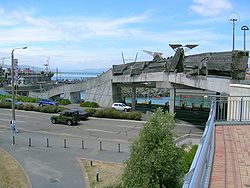
Paratene Matchitt
Encyclopedia

New Zealand
New Zealand is an island country in the south-western Pacific Ocean comprising two main landmasses and numerous smaller islands. The country is situated some east of Australia across the Tasman Sea, and roughly south of the Pacific island nations of New Caledonia, Fiji, and Tonga...
sculptor and painter
Painting
Painting is the practice of applying paint, pigment, color or other medium to a surface . The application of the medium is commonly applied to the base with a brush but other objects can be used. In art, the term painting describes both the act and the result of the action. However, painting is...
. He is known for combining traditional Māori
Maori culture
Māori culture is the culture of the Māori of New Zealand, an Eastern Polynesian people, and forms a distinctive part of New Zealand culture. Within the Māori community, and to a lesser extent throughout New Zealand as a whole, the word Māoritanga is often used as an approximate synonym for Māori...
art forms with those of modernist art. His work also references events from New Zealand history
History of New Zealand
The history of New Zealand dates back at least 700 years to when it was discovered and settled by Polynesians, who developed a distinct Māori culture centred on kinship links and land. The first European explorer to discover New Zealand was Abel Janszoon Tasman on 13 December 1642...
, particularly the Māori prophetic movements of the nineteenth century and most specifically Te Kooti
Te Kooti
Te Kooti Arikirangi Te Turuki was a Māori leader, the founder of the Ringatu religion and guerrilla.While fighting alongside government forces against the Hauhau in 1865, he was accused of spying. Exiled to the Chatham Islands without trial along with captured Hauhau, he experienced visions and...
.
Early life
Paratene Matchitt was born in Tokomaru BayTokomaru Bay
Tokomaru Bay is a small, idyllic beachside community located on the isolated East Coast of New Zealand’s North Island. It is 91 km north of Gisborne, on State Highway 35, and close to Mount Hikurangi. The district was originally known as Toka-a-Namu, which refers to the abundance of sandflies...
, East Cape
East Cape
East Cape is the easternmost point of the main islands of New Zealand. It is located to the north of Gisborne in the northeast of the North Island....
. He is of Te Whānau-ā-Apanui
Te Whanau-a-Apanui
Te Whānau-ā-Apanui is a Māori iwi located in the eastern Bay of Plenty and East Coast regions of New Zealand's North Island. In 2006, the iwi registered 11,808 members, representing 13 hapu.-Early history:Apanui Ringamutu is the founding ancestor of the iwi...
, Te Whakatōhea
Te Whakatohea
Te Whakatōhea are a Māori iwi located in the eastern Bay of Plenty region of New Zealand. The iwi comprises six hapu: Ngāi Tamahaua, Ngāti Ira, Ngāti Ngahere, Ngāti Patumoana, Ngāti Ruatakena and Te Ūpokorehe. In the 2006 Census, 12,072 people claimed an affiliation with Te Whakatōhea.The iwi is...
and Ngāti Porou
Ngati Porou
Ngāti Porou is a Māori iwi traditionally located in the East Cape and Gisborne regions of the North Island of New Zealand. Ngāti Porou has the second-largest affiliation of any iwi in New Zealand, with 71,910 registered members in 2006...
descent. Matchitt attended St Peter’s Maori Boys College.
Artist
Matchitt's art formation began with helping his father and grandfather on his workshop at Edgecombe. He went to Auckland Teachers' Training College in 1955 and 1956. After graduating as a teacher, he took a Dunedin-basedDunedin
Dunedin is the second-largest city in the South Island of New Zealand, and the principal city of the Otago Region. It is considered to be one of the four main urban centres of New Zealand for historic, cultural, and geographic reasons. Dunedin was the largest city by territorial land area until...
course in teaching arts and crafts in schools. In 1957, he began his career as arts and craft adviser for the South Auckland Education Board. He was one of the artists who pursued Māori Arts and Crafts courses at Ruatoria
Ruatoria
The town of Ruatoria is located in the East Coast region of New Zealand's North Island. It is the second largest centre of population in the sparsely populated region, yet has a population of only 900 .- Geography :...
with Pine Taiapa. In November 1964, Matchitt was exhibited with other major Māori artists (Clive Arlidge and Fred Graham) in Hamilton
Hamilton, New Zealand
Hamilton is the centre of New Zealand's fourth largest urban area, and Hamilton City is the country's fourth largest territorial authority. Hamilton is in the Waikato Region of the North Island, approximately south of Auckland...
At the time of the Te Pakanga commission (one of his greatest bodies of work) in 1974, Matchitt was an Arts Advisory Officer in South Auckland. Matchitt is best known for his large-scale public sculpture such as the City to Sea Bridge
City to Sea Bridge
The City to Sea Bridge is a pedestrian bridge and public artwork located in Wellington City, New Zealand. Opened in 1994, the wedge-shaped bridge crosses arterial road Jervois Quay, connecting the public spaces of...
in Wellington
Wellington
Wellington is the capital city and third most populous urban area of New Zealand, although it is likely to have surpassed Christchurch due to the exodus following the Canterbury Earthquake. It is at the southwestern tip of the North Island, between Cook Strait and the Rimutaka Range...
(1993) and Auckland’s Aotea Centre
Aotea Centre
The Aotea Centre is a performing arts and events centre / theatre in the Auckland CBD, Auckland City, New Zealand. Located at the western edge of Aotea Square, off Queen Street, the centre provides cultural venue space in the heart of the city and is managed by 'The Edge'...
(1989).

